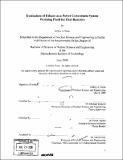| dc.contributor.advisor | Michael Driscoll. | en_US |
| dc.contributor.author | Perez, Jeffrey A | en_US |
| dc.contributor.other | Massachusetts Institute of Technology. Dept. of Nuclear Science and Engineering. | en_US |
| dc.date.accessioned | 2009-03-16T19:49:11Z | |
| dc.date.available | 2009-03-16T19:49:11Z | |
| dc.date.issued | 2008 | en_US |
| dc.identifier.uri | http://hdl.handle.net/1721.1/44836 | |
| dc.description | Thesis (S.B.)--Massachusetts Institute of Technology, Dept. of Nuclear Science and Engineering, 2008. | en_US |
| dc.description | "June 2008." | en_US |
| dc.description | Includes bibliographical references (p. 39-40). | en_US |
| dc.description.abstract | A supercritical ethane working fluid Brayton power conversion system is evaluated as an alternative to carbon dioxide. The HSC® chemical kinetics code was used to study thermal dissociation and chemical interactions for ethane and other coolants under a variety of conditions. The NIST database was used for reaction rates. Overall results were not conclusive. The supercritical behavior of ethane at high pressures is not well documented, and the recombination rates of its dissociation reactions could prove very important. Ethane is known to crack into ethylene, but computer simulations show that it can, at equilibrium, also form significant amounts of hydrogen and methane. These reactions cracked more than 25% of the ethane above 300°C, even though high (20 MPa) pressure significantly reduced dissociation compared to results at 0.1 MPa. At high pressure it appears that ethane might recombine much faster than it dissociates, which would be highly advantageous. Further research and experimentation is encouraged. Simple experiments should be sufficient to identify the behavior of ethane at high temperatures and pressures. Ethane was calculated to have better heat transfer properties than carbon dioxide. In particular, heat exchanger sizes could be reduced by as much as a factor of three. On the other hand, more turbomachinery stages are needed. A simple experiment is proposed to determine whether recombination under compressor inlet conditions is sufficiently fast and complete to make the use of ethane a practical proposition. The chemical reaction of ethane with sodium, while it generates hydrogen, is endothermic, which may quench the reaction in the event of small heat exchanger leakage. | en_US |
| dc.description.statementofresponsibility | by Jeffrey A. Perez. | en_US |
| dc.format.extent | 54 p. | en_US |
| dc.language.iso | eng | en_US |
| dc.publisher | Massachusetts Institute of Technology | en_US |
| dc.rights | M.I.T. theses are protected by
copyright. They may be viewed from this source for any purpose, but
reproduction or distribution in any format is prohibited without written
permission. See provided URL for inquiries about permission. | en_US |
| dc.rights.uri | http://dspace.mit.edu/handle/1721.1/7582 | en_US |
| dc.subject | Nuclear Science and Engineering. | en_US |
| dc.title | Evaluation of ethane as a power conversion system working fluid for fast reactors | en_US |
| dc.type | Thesis | en_US |
| dc.description.degree | S.B. | en_US |
| dc.contributor.department | Massachusetts Institute of Technology. Department of Nuclear Science and Engineering | |
| dc.identifier.oclc | 301577255 | en_US |
